|
Types of Wood and Wood SpeciesWhen installing a hardwood floor, it is important to consider the types of wood and wood species that will give you the look that you want for your room. Appearance of Red Oak Hardwood Floors: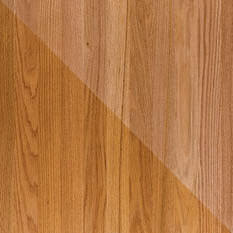
Color: Heart and sapwood are similar with sapwood lighter in color; most pieces have a reddish tone. Slightly redder than white Red Oak Wood Floors Grain: Open, slightly coarser (more porous) than white oak. Plainsawn boards have a plumed or flared grain appearance; riftsawn has a tighter grain pattern, low figuring; quartersawn has a flake pattern, sometimes called tiger oak, tiger rays or butterflies. Availability: Commodity item available in ALL types, styles and sizes of flooring Properties: Hardness: 1290 Janka Table (benchmark) Durability: Stiff & dense, resist wear, less durable than white oak.Workability: Sawing: above average Nailing: good Sanding: satisfactorily, better than white oak Finishing: Strong stain contrast, because of pores Appearance of White Oak Wood Floors: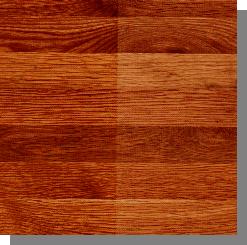
Color: Heartwood is light brown; some boards may have a pinkish tint or a slight grayish cast. Sapwood is white to cream Grain: Open, with longer rays than red oak. Occasional crotches, swirls and burls. Plainsawn boards have a plumed or flared grain appearance; riftsawn has a tighter grain pattern, low figuring; quartersawn has a flake pattern, sometimes called tiger oak, tiger rays, or butterflies Availability: Commodity item, available in ALL types, styles and sizes of flooring Properties: Hardness of White Oak Hardwood Floors: 1360 Jankas Table, 5% harder than Northern red oak Durability: More durable than red oak. Tannic acid in the wood protects it from fungi and insects Workability: Sawing: good Nailing: good Sanding: satisfactory Finishing: Absorbs finishes more evenly than red oak. Appearance of Maple Wood Floors: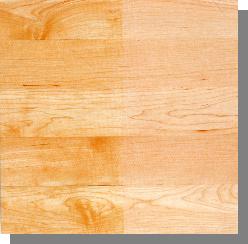
Color: Maple Heartwood is creamy white to light reddish brown; Sapwood is pale to creamy white. Maple Wood Floors Grain: Closed, subdued grain, with medium figuring and uniform grain texture. Occasionally shows quilted, fiddle back, curly or bird's-eye figuring. Figured boards often culled during grading and sold at a premium. Availability: Commodity item; figured grains limitedProperties of Maple Wood Floors: Hardness: 1450 janka Table, 12% harder than Northern red oak Durability: Dense, strong, tough, stiff, often used in bowling alleys and sports floors Workability: Sawing: Density makes it difficult Nailing: good, fair resistance to splitting Sanding: satisfactorily Finishing: Good in natural finish, DOES NOT stain uniformly Appearance of Cherry Wood Floors: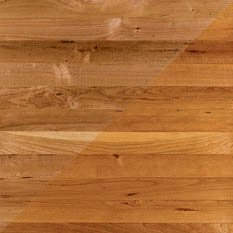
Color: Heartwood is dark to reddish brown, lustrous; sapwood is light brown to pale with a light pinkish tone. Some manufacturers steam lumber to bleed the darker heartwood color into the sapwood, resulting in a more uniform color. Cherry Wood Floor Grain: Fine, frequently wavy, uniform texture. True quartersawn has distinctive flake pattern. Texture is satiny, with some gum pockets. Availability: Limited Properties: Hardness: 950 janka Table, 26% softer than Northern red oak Durability: Strong, moderately hard. Usually considered too soft for an entire floor-mostly used for accents and bordersWorkability: Sawing: Good Nailing: Good Sanding: Satisfactorily Finishing: No known Appearance of Pine Wood Floors: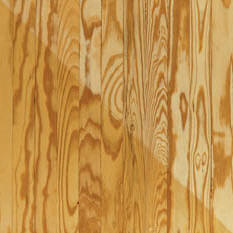
Color: Heartwood varies from light yellow/orange to reddish brown or yellowish brown; sapwood is light tan to yellowish white. Grain: Closed, with high figuring; patterns range from clear to knotty. Availability: Commodity item, unfinished strip, planks Hardness: 690 Janka Table 47% softer than Northern red oak; longleaf 870 Janka Table, 33% softer than Northern red oak. Durability: Soft, fairly durable, not as resist to scuff, & dents as true hardwoods Workability: Sawing: good Nailing: good Sanding: Resin tends to clog sand paper, frequent paper changes are required Finishing: Using durable finishes can help minimize wear. Appearance of Walnut Wood Floors: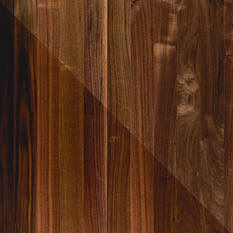
Color: Heartwood ranges from a deep, rich dark brown to a purplish black. Sapwood is nearly white to tan. Difference between heartwood and sapwood is great; some manufacturers steam the wood to bleed the darker heartwood color into the sapwood. Grain: Mostly straight and open, but some boards have burled or curly grain. Availability: Moderately Properties: Hardness: 1010 Janka Table, 22% softer than Northern red oak Durability: Moderately dense, very strong Workability: Sawing: excellent Nailing: Fair Sanding: satisfactorily Finishing: Nice Other Names:American Walnut,Black Walnut,Burbank Walnut,Eastern Black Walnut,Eastern Walnut,Gunwood,North American Walnut, and Virginia Walnut Appearance of Ash Wood Floors: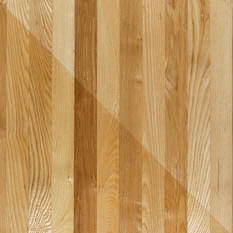
Appearance: Ash Wood Flooring Heartwood is light tan to dark brown; sapwood is creamy white. Similar to white oak but more yellow Grain: Bold, straight, moderately open grain with occasional wavy figuring, and can have strong contract in grain in plainsawn ash wood flooring boards. Availability: Moderately available Properties: Hardness: 1230% Janka Table, 2% harder than Northern red oak Durability: Elastic, hard, excellent shock resistance. Workability: Good Sawing, Good Nailing, Good resistance to splitting sanding. Ash Wood Floors Stains well, no known finishing problems Appearance of Hickory Wood Floors: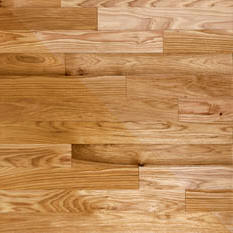
Color: Pecan heartwood is reddish brown with dark brown stripes; sapwood is white or creamy white with pinkish tones. Hickory heartwood is tan or reddish; sapwood is white to cream, with fine brown lines Grain: Pecan is open, occasionally wavy or irregular. Hickory is closed, with moderate definition; somewhat rough-textured. Availability: Readily, not parquet patterns Hardness: 1820 Janka Table, 41% harder than Northern red oak Durability: Combination of strength, hardness, toughness and stiffness not found in other commercial wood. Workability: Difficult to season, good Nailing, prone to splitting Sanding: Difficult due to density, sanding marks may show Finishing: No known problems Appearance of Birch Wood Floors: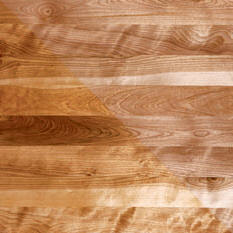
Color: Sapwood is creamy yellow or pale white in yellow birch; heartwood is light reddish brown tinged with red. Sweet birch has light colored sapwood and heartwood is dark brown tinged with red Birch Wood Flooring Grain: Medium figuring, straight, closed grain, even textured. Occasional curly grain or wavy figure in some boards. Availability: Moderately Properties: Hardness:1260 Janka Table, 2% softer than Northern red oak. Durability: Hard and stiff; very strong. Sawing: With good machine tools, difficult with hand tools. Nailing: Excellent Sanding: Satisfactorily Finishing: No known problems Appearance of Beech Wood Floors: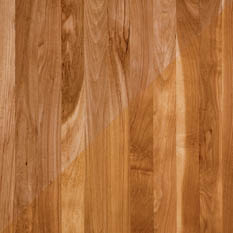
Color: Reddish brown heartwood, with pale white sapwood Grain:Mostly closed, straight grain, uniform texture. Coarser than European beech Availability: Limited Hardness:1300% Janka Table, 1% harder than Northern red oak Durability:Elastic, hard; excellent shock resistance. Wears wells, stays smooth when subjected to friction - popular for factory floors. Sawing: Good with machine tools, difficult to work with hand tools. Nailing: Good holding ability, has tendency to split. Sanding and Finishing: No known problems Appearance of Mesquite Wood Floors: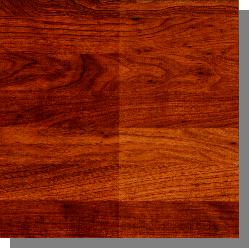
Color: Light brown to dark reddish brown Grain: High in character, with ingrown bark and mineral streaks. Used in end-grain flooring blocks. Availability: Moderately Hardness: 2345 Janka Table, 82% harder than Northern red oak Durability: Dense and very strong Workability: Very good Nailing, splits easily Sanding: good with end grain requiring #16 grit paper to cut properly Finishing: No known problems Appearance of Heart Pine Wood Floors: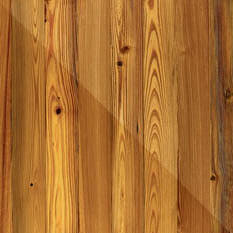
Color: Heartwood is yellow after cutting and turns deep pinkish tan to warm reddish brown within weeks due to high resin content. Sapwood remains yellow, with occasional blue-black sap stain. Grain of Heart Pine Wood Floors: Dense, with high figuring. Plainsawn is swirled; rift or quartersawn is primarily pinstriped. Curly or burl grain is rare. Availability: Limited Properties of Pine Wood Floors: Hardness: 1225 Janka Table, 5% sifter than Northern red oak. Durability: Natural resistance to insects in heartwood; dense Sawing: Good Nailing: Good Sanding: Use course paper for 1st sanding, may clog paper. Finishing: Accepts surface and penetrating finishes, some stains tend to blotch Appearance of Douglas Fir Wood Floors: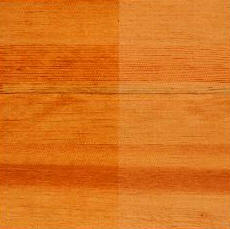
Color: Douglas Fir Wood Floors are a Yellowish tan to light brown heartwood. Sapwood is tan to white Heartwood may be confused with that of Southern yellow pine. Radical color change upon exposure to sunlight. Grain: Grain: Normally straight, with occasional wavy or spiral texture. Nearly all fir flooring is vertical grain or riftsawn clear grade material Availability: Readily available Hardness: 660 Janka Table,49% softer than Northern red oak Durability: Durable but easily dented like soft pine Sawing: Harder to work with hand tools than soft pines. Nailing: Good Sanding: Satisfactorily Finishing: May change color with some finishing products, and care must be taken to avoid over sanding.
Imported Wood Species: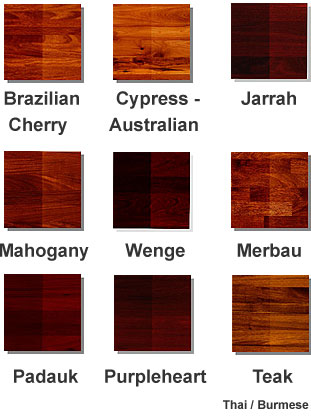
Schedule your Free On-Site Consultation today! Call 216-328-1057Serving: Cuyahoga County ~ Lake County ~ Geauga County ~ Medina County ~ Lorain County ~ Summit County |




